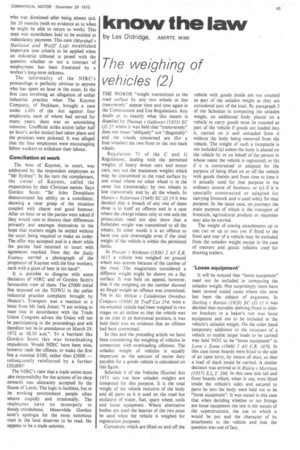know the law
Page 45

If you've noticed an error in this article please click here to report it so we can fix it.
by Les Oldridge, AMIRTE, MIMI
The weighing of vehicles (2)
THE WORDS "weight transmitted to the road surface by any two wheels in line transversely" appear time and time again in the Construction and Use Regulations. Any doubt as to exactly what this means is dispelled by Thomas v Galloway (1935) SC (J) 27 where it was held that "transversely" does not mean "obliquely" nor "diagonally" and the wheels concerned are (for a four-wheeler) the two front or the two back wheels.
Regulation 71 of the C and U Regulations, dealing with the permitted weights of heavy motor cars and motor cars, sets out the maximum weights which may be transmitted to the road surface by one wheel where no other wheel is in the same line transversely; by two wheels in line transversely and by all the wheels. In Martin y Robertson (1949) SC (J) 19 it was decided that a breach of any one of these three is in itself an offence and in a case where the charge relates only to one axle the prosecution need not also show that a forbidden weight was transmitted to all the wheels. In other words it is an offence to have one axle overweight even if the total weight of the vehicle is within the permitted limits.
In Prosser v Richings (1936) 2 All E.R. 1617 a vehicle was weighed on ground which was uneven because of the camber of the road. The magistrates considered a different weight might be shown on a flat surface. It was held on appeal, however, that if the weighing on the camber showed an illegal weight an offence was committed. Yet in Me Milton v Caledonian Omnibus Company (1938) 26 Traff Cas 374, were a six-wheeled vehicle had been weighed in two stages on an incline so that the vehicle was at no time in an horizontal position, it was held there was no evidence that an offence had been committed.
In this and the preceding article we have been considering the weighing of vehicles in connection with overloading offences. The unladen weight of vehicles is equally important as the amount of excise duty payable for a goods vehicle is calculated on this figure.
Schedule 6 of the Vehicles (Excise) Act 1971 sets out how unladen weights are computed for this purpose. It is the total weight of the vehicle inclusive of the body and all parts as it is used on the road but exclusive of water, fuel, spare wheel, tools and loose equipment. Where alternative bodies are used the heavier of the two must be used when the vehicle is weighed for registration purposes.
Containers which are lifted on and off the vehicle with goods inside are not counted as part of the unladen weight as they are considered part of the load. By paragraph 3 of the Schedule in computing the unladen weight, an additional body placed on a vehicle to carry goods must be counted as part of the vehicle if goods are loaded into it, carried on it and unloaded from it without the body being removed from the vehicle. The weight of such a receptacle is not included (a) unless the body is placed on the vehicle by or on behalf of the person in whose name the vehicle is registered; or (b) if it is constructed or adapted for the purpose of being lifted on or off the vehicle with goods therein and from time to time it is actually used for that purpose in the ordinary course of business; or (c) if it is specially constructed or adapted for carrying livestock and is used solely for that purpose. In the latter case, on journeys the main purpose of which is the transport of livestock, agricultural produce or requisites may also be carried.
The weight of towing attachments up to one cwt or up to two cwt if fitted to the front and rear of a vehicle may be excluded from the unladen weight except in the case of tractors and goods vehicles used for drawing trailers.
'Loose equipment' It will be noticed that "loose equipment" need not be included in computing the unladen weight. Not surprisingly there have been several stated cases where this term has been the subject of argument. In Darling v Burton (1928) SC (J) 11 it was decided that movable shelving fitted to slideon brackets in a baker's van was loose equipment and not to be included in the vehicle's unladen weight. On the other hand temporary additions to the structure of a vehicle to enable larger loads to be carried was held NOT to be "loose equipment" in Lowe v Stone (1948) 2 All E.R. 1076. In this case loose boards were fitted to the side of an open lorry, by means of slots, so that a load of slack could be carried. A similar decision was arrived at in Blakie v Morrison (1957) S.L.T. 290. In this case side tail and front boards which, when in use, were fitted inside the vehicle's sides and secured to parts let into the body were held not to be "loose equipment". It was stated in this case that when deciding whether or not fittings are loose equipment the test is the nature of the superstructure, the use to which it would be put and the character of its attachment to the vehicle and that the question was one of fact.












































































